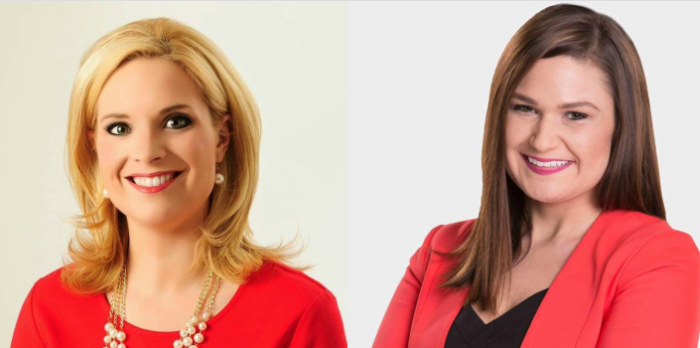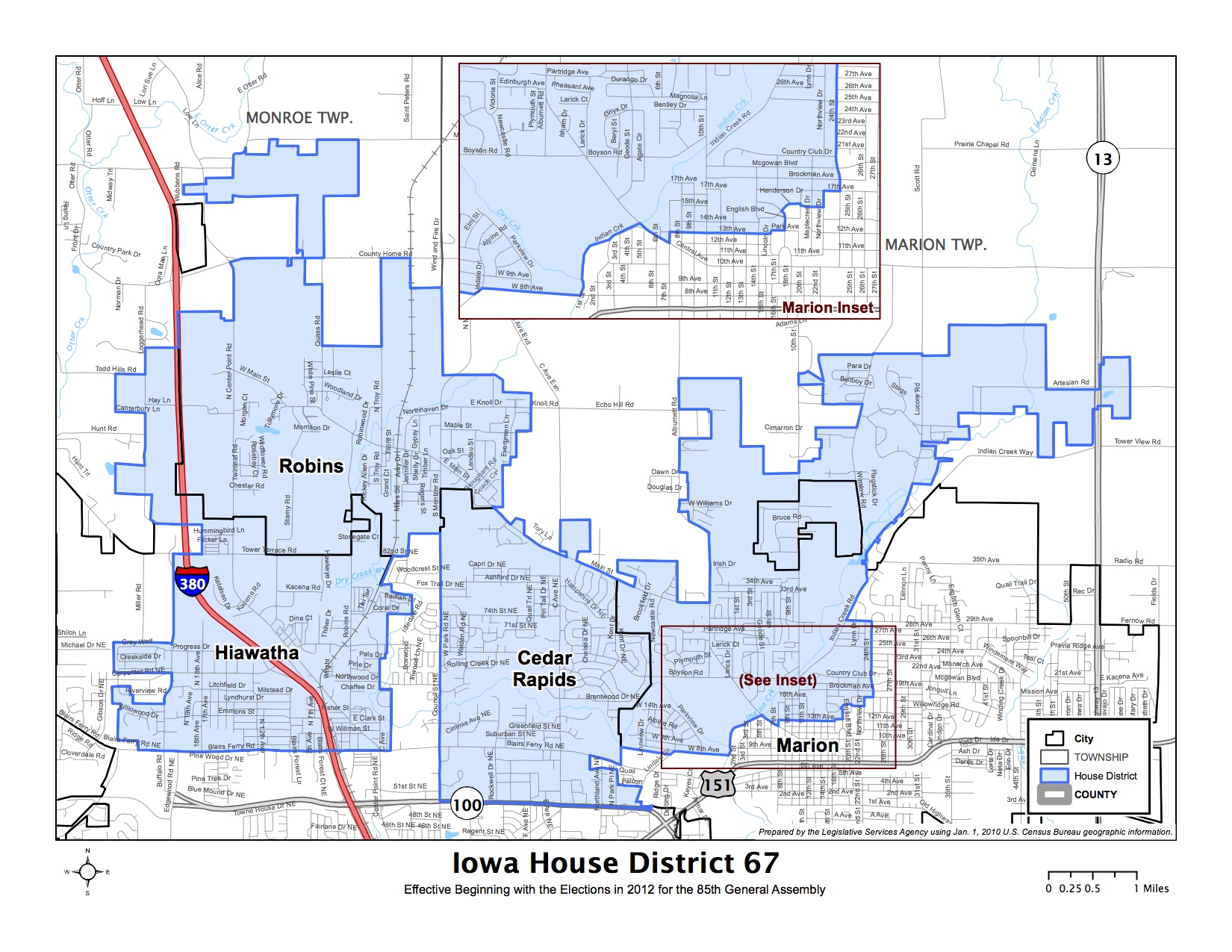UPDATE: Hinson filed a statement of candidacy with the Federal Election Commission on May 13.
“I am considering my options and hope to make a decision in the next few weeks,” State Representative Ashley Hinson told WHO-TV’s Dave Price on January 18 regarding a possible campaign for Congress in 2020.
Since former state lawmaker Abby Finkenauer defeated U.S. Representative Rod Blum in November, insiders in both parties have speculated that Hinson could be the GOP’s best chance for winning back the first Congressional district. Both parties will certainly target this race, rated a toss-up by Sabato’s Crystal Ball and the Cook Political Report.
WHY REPUBLICANS WANT A CANDIDATE FROM LINN COUNTY
Hinson grew up in West Des Moines but has spent most of her career in the Cedar Rapids area. While Linn County doesn’t dominate IA-01 the way Polk County (containing the Des Moines area) does in IA-03, Linn is home to far more registered voters than any other county in the first district. Last fall, more than a third of ballots cast for Finkenauer and more than a quarter of those for Blum came from Linn County residents.
This interactive map shows the vote totals and percentages for Blum and Finkenauer in each county.
County Name
| D | Canidate 1 | 61% | 30390 |
| R | Canidate 2 | 39% | 10390 |
Finkenauer between 50% and 60%
Blum won with less than 50%
Blum between 50% and 60%
Here are the same results in a table, with counties in descending order from most to least votes cast in the Congressional race. All figures reflect official numbers from the Iowa Secretary of State’s website.
| How Abby Finkenauer and Rod Blum performed in IA-01 counties | ||||
| County | Finkenauer votes | Finkenauer vote share | Blum votes | Blum vote share |
|---|---|---|---|---|
| Linn | 57,712 | 56.7% | 40,733 | 40.0% |
| Black Hawk | 29,667 | 55.9% | 22,103 | 41.6% |
| Dubuque | 22,359 | 52.3% | 19,282 | 45.1% |
| Marshall | 6,611 | 46.7% | 7,124 | 50.4% |
| Benton | 4,698 | 40.8% | 6,465 | 55.8% |
| Bremer | 5,182 | 45.4% | 5,908 | 51.7% |
| Winneshiek | 5,102 | 51.8% | 4,364 | 44.3% |
| Jones | 3,787 | 44.2% | 4,490 | 52.4% |
| Jackson | 3,797 | 44.6% | 4,483 | 52.7% |
| Buchanan | 3,977 | 47.1% | 4,166 | 49.3% |
| Poweshiek | 3,966 | 48.1% | 4,044 | 49.1% |
| Fayette | 3,701 | 45.2% | 4,167 | 50.8% |
| Clayton | 3,311 | 42.0% | 4,320 | 54.7% |
| Iowa | 3,099 | 40.8% | 4,203 | 55.3% |
| Delaware | 2,810 | 37.5% | 4,475 | 59.7% |
| Tama | 3,257 | 44.7% | 3,780 | 51.9% |
| Allamakee | 2,353 | 41.6% | 3,073 | 54.4% |
| Mitchell | 1,836 | 40.8% | 2,518 | 55.9% |
| Howard | 1,587 | 44.0% | 1,878 | 52.0% |
| Worth | 1,530 | 43.7% | 1,866 | 53.2% |
| District-wide | 170,342 | 51.0% | 153,442 | 45.9% |
Note that Finkenauer carried Linn County by about 17,000 votes, almost the same as her district-wide margin over Blum. Republicans don’t need to carry Linn to win back the Congressional seat, but they must find a way to keep Finkenauer’s margins down in the Cedar Rapids metro.
HINSON’S APPEAL COULD EXTEND FAR BEYOND LINN COUNTY
Raising name recognition is perhaps the biggest challenge for anyone running against a Congressional incumbent. But Hinson would enter the race with a head start on almost any other potential Republican candidate, having spent ten years as a news anchor, reporter, and producer at KCRG-TV9.
KCRG is the most-watched station for local news in the Cedar Rapids market, which reaches the overwhelming majority of IA-01 residents. Three medium-sized counties are part of the Des Moines market, and the three counties with the smallest populations receive stations based in Rochester, Minnesota.
Clicking on any county on this map will bring up the vote totals and percentages for Blum and Finkenauer, just like on the map above. I changed the color scheme to show which television stations reach each county. (Click here for a map showing media markets for all 99 Iowa counties).
County Name
| D | Canidate 1 | 61% | 30390 |
| R | Canidate 2 | 39% | 10390 |
Cedar Rapids
Rochester, MN
Des Moines
HINSON OUTPOLLED BLUM IN HER DISTRICT
Hinson just won a second term in Iowa House district 67, covering a few Cedar Rapids precincts and parts of the suburbs.
Like suburbs around the country, this area has been trending toward Democrats. Residents of House district 67 favored Mitt Romney over President Barack Obama by 49.5 percent to 49.2 percent in 2012, when Obama won the state by 52 percent to 46 percent. But Hillary Clinton narrowly carried the same precincts in 2016 (47.2 percent to 45.7 percent for Donald Trump), even as Iowa went to Trump by nearly 10 points.
Seeking an open seat in 2016, Hinson won her first race comfortably, 11,248 votes to 6,749 (62.5 percent to 37.5 percent).
Going into the latest election, Republicans had a slight voter registration edge in House district 67, while Democrats had returned more absentee ballots. Uncharacteristically for an Iowa legislative campaign, the Democratic Party spent more on behalf of challenger Eric Gjerde than the GOP did for Hinson.
Hinson won a second term, but not by much. Using precinct-level data accessed through Linn County’s election website, I created this table showing results for the Congressional and state House races in all precincts Hinson represents.
Across the board, Hinson’s vote share was 5 to 8 points higher than Blum’s. The red boxes highlight that Blum carried only three of the thirteen precincts in House district 67, while Hinson carried nine. (Note: percentages for the Congressional race don’t add up to 100, because a Libertarian was also on the ballot.)
| How Abby Finkenauer and Ashley Hinson performed in House district 67 precincts | ||||||||
| Precinct | Finkenauer votes | Finkenauer share | Blum votes | Blum share | Gjerde votes | Gjerde share | Hinson votes | Hinson share |
|---|---|---|---|---|---|---|---|---|
| CR 3 | 677 | 55.0% | 519 | 42.2% | 643 | 52.7% | 576 | 47.2% |
| CR 4 | 626 | 50.3% | 590 | 47.4% | 579 | 46.5% | 665 | 53.4% |
| CR 5 | 832 | 59.1% | 530 | 37.6% | 810 | 57.8% | 590 | 42.1% |
| CR 6 | 747 | 53.5% | 599 | 42.9% | 684 | 49.6% | 695 | 50.4% |
| Hiawatha 1 | 824 | 52.1% | 702 | 44.4% | 767 | 48.8% | 803 | 51.1% |
| Hiawatha 2 | 561 | 61.0% | 322 | 35.0% | 541 | 59.5% | 368 | 40.5% |
| Hiawatha 3 | 282 | 51.0% | 259 | 46.8% | 258 | 47.4% | 286 | 52.6% |
| Marion 2 | 459 | 56.5% | 324 | 39.9% | 437 | 54.0% | 372 | 46.0% |
| Marion 11 | 866 | 46.8% | 940 | 50.8% | 759 | 42.2% | 1,040 | 57.8% |
| Marion 12 | 470 | 50.7% | 426 | 46.0% | 446 | 48.4% | 474 | 51.5% |
| Marion 13 | 837 | 53.4% | 687 | 43.8% | 687 | 48.4% | 732 | 51.6% |
| Marion 14 | 628 | 45.2% | 719 | 51.8% | 567 | 42.9% | 754 | 57.0% |
| Robins | 852 | 42.4% | 1,107 | 55.1% | 754 | 37.8% | 1,238 | 62.1% |
| HD-67 total | 8,661 | 51.3% | 7,724 | 45.7% | 7,932 | 48.0% | 8,593 | 52.0% |
Frankly, I expected Hinson to outpoll Blum by more in this district, where she is best known. Blum’s prickly temperament and ethics problems made him an exceptionally weak incumbent.
That said, you can see why many Republicans have encouraged Hinson to run for Congress. If she can improve on Blum’s showing by about 5 points everywhere voters are familiar with her past work in television news, that would make up the GOP’s 2018 deficit district-wide.
SIZING UP A FINKENAUER/HINSON RACE
It’s way too early to guess what the political environment will look like in the fall of 2020, and many northeast Iowa voters shifted toward Republicans in federal and state legislative races in 2016. So I concur with the toss-up rating Cook Political and Sabato’s Crystal Ball have given IA-01. With the wind at Democrats’ backs nationally, a voter registration advantage for her party, and an opponent with a lot of baggage, Finkenauer won by only a 5-point margin.
On the other hand, Finkenauer could enter the next campaign in a stronger position. She should be able to run up the score in her home county if she doesn’t face a Republican from Dubuque, where Blum lived for decades.
Last year, Republicans portrayed “Absent Abby” as too young and inexperienced for the job. She will be better known after holding numerous official events around the district as a member of Congress. Blum cast his first Congressional vote against John Boehner for speaker, resulting in insignificant committee assignments and few legislative accomplishments. In contrast, Finkenauer landed a seat on the U.S. House Transportation and Infrastructure Committee, a good position to deliver tangible benefits to her constituents. Within two weeks of being sworn in, she got her first bill through the House, a bipartisan measure promoting investment in rural small businesses.
One key to Finkenauer’s victory in November was keeping Blum’s margin down in the rural counties. As an incumbent, she should be able to continue to build relationships with voters in smaller communities.
While Hinson would enter a Congressional race with a higher profile than most challengers, her short legislative career provides a lot of fodder for attack ads. A few examples (not an exhaustive list):
Hinson wasn’t eager to defend her voting record during the 2018 campaign. The League of Women Voters hosted candidate forums for most Linn County races, but not House district 67. Gjerde accepted the group’s invitation; Hinson did not agree to participate. As a Congressional candidate, she won’t be able to avoid tough questions about her legislative work.
Any comments about the IA-01 race are welcome in this thread.
UPDATE: I forgot to mention that Hinson voted for the 2017 omnibus gun bill, which was so extreme that two Iowa House Republicans opposed it. If Hinson runs she can expect substantial support from the National Rifle Association and other pro-gun groups.
Top image: On the left, Republican State Representative Ashley Hinson. On the right, Democratic U.S. Representative Abby Finkenauer.



1 Comment
Good Analysis.
I spent a lot of time knocking doors in that district. I think that people were turning away from the far right agenda in the Iowa Legislature – but only those who were better informed. Many voters were staunchly apolitical, and further analysis may conclude that many of those voters stayed home. A campaign focused on educating voters could gain ground – especially in a high turnout presidential year.
Ashley Hinson showed herself to be somewhat thin skinned when called out on her Iowa Legislative votes. The key would be to hold her to account.
EmilyatActivate Tue 22 Jan 6:09 PM